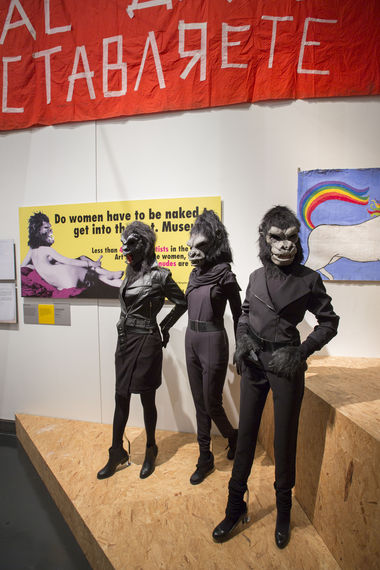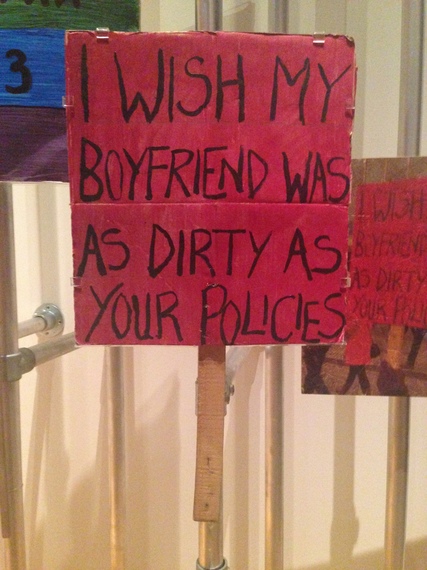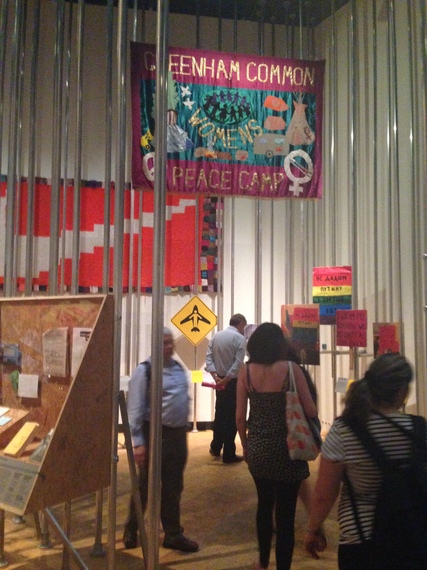
It was a great idea to also include some of the vicious mail that Guerrilla Girls have received, as an example of the resistance these protests can provoke. A letter from an Italian art critic, referring to the women as "bitch feminists" shows the level of misogyny that feminists face. "The only thing you feminists teach is to women to be hoars (sic) in love" the letter goes on.
The V&A has also borrowed many distinctive placards from recent protests such as those against tuition fees in the UK and the Occupy movements in London and New York. One that caught the eye was Coral Stoakes' "I Wish My Boyfriend Was As Dirty As Your Policies." It's quick-witted but bitingly satirical slogans such as this that catch the eye of the media, and therefore boost the profile of the protests.

So brilliant was this design, that protestors defended themselves from police brutality with the pen rather than the sword, that these were developed and used by other protests such as Manchester in 2011 and New York in 2013, with book covers such as To Kill A Mockingbird and Brave New World poignantly used.
The power of these disobedient objects has also been profound.
I was genuinely thrilled to see one of the McLibel pamphlets included from 1986, one that resulted in a huge PR disaster for McDonalds. Also included was an example of a street sign used in Buenos Aires to identify - name and shame - residences of the Generals who were in charge during the years of the Disappeared.
How the art and design of these disobedient objects incorporates local and regional traditions was one of the most fascinating aspects of this display.

Arpilleras are appliqued textiles made by women in South America that are used to tell stories and those collated here have been used to record massacres and injustices, whether it was the Mampujan Massacre of 2010 in Columbia, where in one night a village was burnt to the ground and the women were violently raped by the army for their opposition to the dictatorship, or to record the violence of the Pinochet regime in Chile back in 1980.
I found this a very emotive exhibition, one that drives up a lot of anger and frustration.
Supporting the exhibits is a number of video clips, including footage from protests such as Tiananmen, the Middle East, Seoul and Japan. The level of violent resistance from the state in almost all instances is incredibly depressing.
And the disproportionate use of that violence can be harrowing to watch. Watching again the tanks of the Chinese Army toppling over the 30ft Goddess of Democracy in Tiananmen Square was quite distressing, as it was to see the footage from Palestine of kids throwing stones with their slingshots, only for their pebbles to be met with gunfire.

Included in the video clips is commentary and observation from those that have been active in protest movements, or who have studied them.
It's eye-opening to listen to how these movements do bring in the egalitarian principles and community consciousness they want to see in the world, but how they also struggle with gender and class structures within their own ranks.
But it was easy to agree with these commentators that change has only come about from direct action, from challenges to property and power, rather than negotiation and dialogue.

As journalist Laurie Penny observes in one of the video clips, the view of many of the suffragettes now is one of quite twee women in their long skirts and pretty bonnets organising fetes and drinking tea.
But these women were incredibly violent, the terrorists of their era. Pankhurst's methods were innovative and ground-breaking, creating the template for so many civil rights movements to follow. The WSPU was the first to use art and design on a mass scale to create an identity, a brand.
How disappointing then that the WSPU was represented by a bespoke teacup and saucer, somewhat reinforcing that passive representation. What opportunity there was to put on show a meat cleaver or one of the hammers that were used in the window-breaking, which showed that Pankhurst had realised the impact of damage to property.
No comments:
Post a Comment